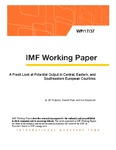Please use this identifier to cite or link to this item:
http://thuvienso.quochoi.vn/handle/11742/39076Full metadata record
| DC Field | Value | Language |
|---|---|---|
| dc.contributor.other | Faezeh Raei | - |
| dc.contributor.other | Ara Stepanyan | - |
| dc.creator | Jiří Podpiera | - |
| dc.date.issued | January 2017 | - |
| dc.identifier.uri | http://hdl.handle.net/11742/39076 | - |
| dc.description.abstract | Was the postcrisis growth slowdown in Central, Eastern and Southeastern Europe (CESEE) structural or cyclical? We use three different methods—production function approach, basic multivariate filter, and multivariate filter with financial frictions—to evaluate potential growth and output gaps for 18 CESEE countries during 2000-15. Our findings suggest that potential growth weakened significantly after the crisis across most countries in the region. This decline appears to be largely due to stagnant productivity and weaker capital accumulation, which were associated with common external factors, including trading partners’ slow potential growth, but also decline in global trade and stalled expansion of global value chains. Our estimates suggest that output gaps in 2015 were largely closed in many countries in the region. | - |
| dc.language | en_US | vi |
| dc.publisher | IMF Working Paper | vi |
| dc.rights | IMF Working Paper | vi |
| dc.subject | Potential output | vi |
| dc.subject | Output gap | vi |
| dc.subject | Emerging Markets | vi |
| dc.title | A Fresh Look at Potential Output in Central, Eastern, and Southeastern European Countries | vi |
| dc.type | Báo cáo | vi |
| dc.source.method | IMF Working Paper | - |
| Appears in Collections: | Phân quyền - Ngoại giao | |
Files in This Item:
Items in DSpace are protected by copyright, with all rights reserved, unless otherwise indicated.

THƯ VIỆN QUỐC HỘI - VĂN PHÒNG QUỐC HỘI
Địa chỉ: Nhà Quốc Hội, Đường Độc Lập, Ba Đình, Hà Nội
Điện thoại: 080.41947
Email: thuvienquochoi@quochoi.vn




